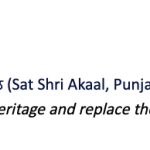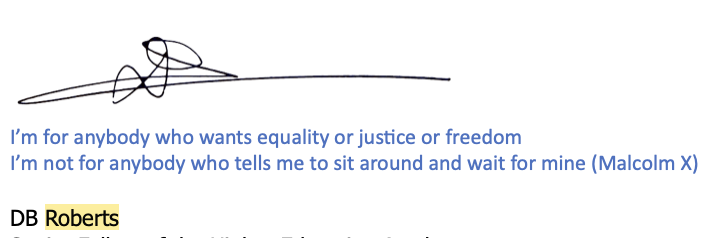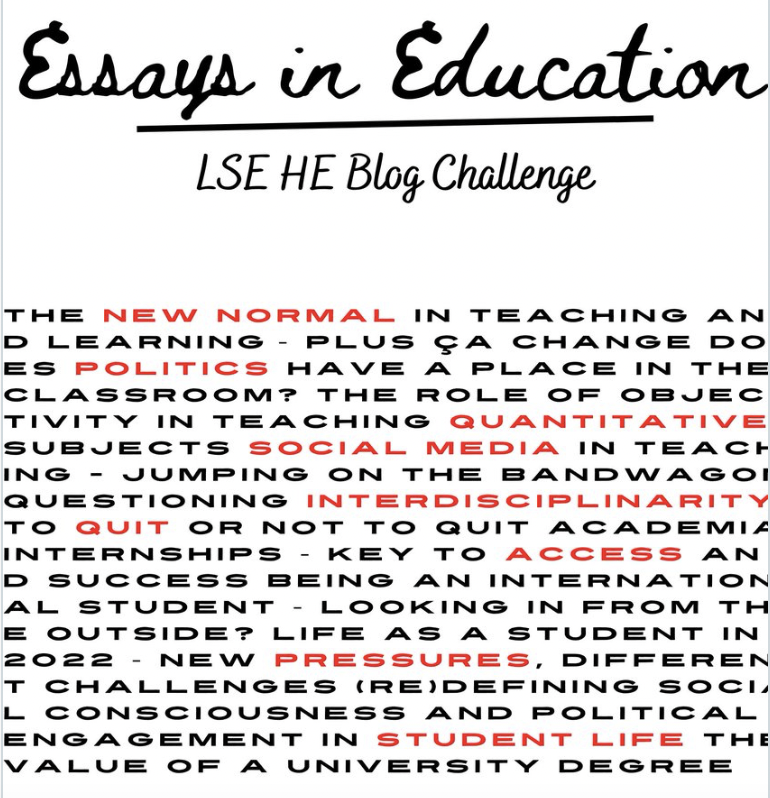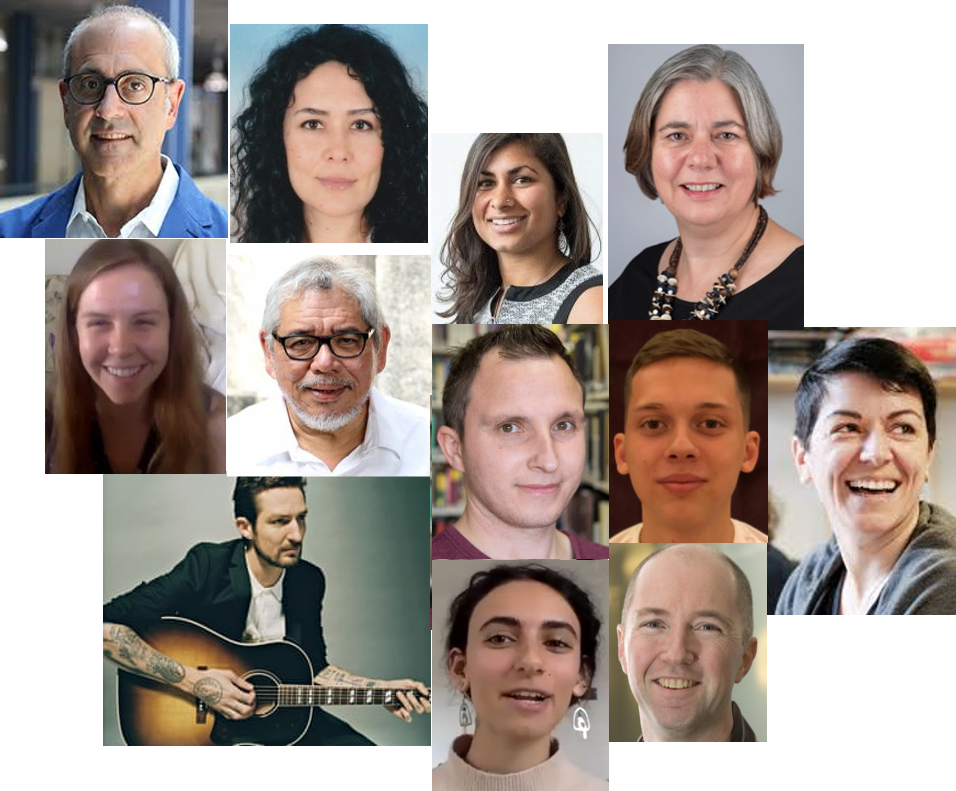What does your email signature say about you? In addition to basic information about your role and institution, educational qualifications, and professional affiliations, email signatures are often where academics take a stand, whether it’s about identity, politics, values, or beliefs. Is it the electronic version of wearing your heart on your sleeve?
We speak to four academics, Chloe Farahar, Sunil Kumar, David Roberts, and Rebecca Murray about their email signatures – why did they choose to include these aspects in their email signatures, and what message does it send?

“I use my signature line in training as a means of demonstrating how to convey needs and boundaries with others.”
Chloe Farahar, University of Kent
 “Others, in their communication with me, have reciprocated with their own vernacular greetings.”
“Others, in their communication with me, have reciprocated with their own vernacular greetings.”
Sunil Kumar, London School of Economics
 “Brother Malcolm’s remark is a means of speaking truth to power amid the anodyne management email tails…”
“Brother Malcolm’s remark is a means of speaking truth to power amid the anodyne management email tails…”
David Roberts, Loughborough University
 “My email signature is designed to avoid generating unnecessary enquiries and minimise the number of emails I need to write.”
“My email signature is designed to avoid generating unnecessary enquiries and minimise the number of emails I need to write.”
Rebecca Murray, University of Sheffield
 Dr Chloe Farahar
Dr Chloe Farahar
Social psychologist and Autistic consultant, University of Kent
I started using the sentence “PLEASE NOTE: Tone and intonation are not easily conveyed via email. I (Chloe) will usually be polite and to the point in emails.” as some of my peers and colleagues considered me rude in emails, particularly those who hadn’t met me in person, but had cause to email me. After I included this sentence, and highlighted that I am Autistic, peers and colleagues were more understanding or seemed polite in their replies to me. A colleague actually told me it helped them not read my short, blunt emails as rude.
Although I don’t believe anyone has directly referred to my signature in emails, people have commented positively about my signature in meetings or training. I use my signature line in training as a means of demonstrating how to convey needs and boundaries with others, and how straightforward that can be at times – as straightforward as my short sentence that conveys that I communicate differently, and what recipients should expect in terms of my communication. This is important as I get many emails and I have issues with fatigue and exhaustion, so anything that reduces the cognitive load, such as not having to remember and type sentences or paragraphs of neurotypical small talk, helps.
I also include my pronouns to normalise the use of pronouns for everyone, and highlight that I am an Autistic person, not a ‘person with autism,’ as a small teaching moment and to hopefully remind people not to consider me as someone with a disorder attached to me, as I am an Autistic human, not a human with a disorder.

 Dr Sunil Kumar
Dr Sunil Kumar
Lecturer in Social Policy and Development, London School of Economics, UK
In a cultural sense, names and valedictions are inseparable. All cultures have their own greetings and valedictions, some of them, many. As someone with mixed Indian heritage – Tamil and Punjabi – I inherited two cultures. Having migrated to the UK more than three decades ago, the valedictions in my signature conformed to the host nation’s sign-offs such as ‘thanks,’ ‘best wishes,’ and ‘regards’.
However, several years ago, due to greater engagement with decolonial thinking, I reflected on the idea of migrant conformity and mustered the courage to make my mixed heritage known – something that my name alone does not convey. I began signing off with Tamil and Punjabi valedictions. I use the word ‘muster’ because doing so wasn’t easy. Subconsciously, the immigrant mindset of expectations to integrate was strong and it took some effort to overcome.
Even now, I sometimes reflect on whether the valedictions I use are an imposition on others. Thankfully, such thoughts have been fleeting. The recognition of the power of the valedictions that I use has come, in the main, from Indian students who have said that they have felt a sense of connection and pride. Others, in their communication with me, have reciprocated with their own vernacular greetings.


 David Roberts
David Roberts
Senior Lecturer in International Relations, Loughborough University
I have for some time been conscious of fads in HE email tails, but have become more engaged as my published research on university elites began to show that university senior management teams (USMT) are ill-equipped to lead structural change in domains like non-binary identity representation and inclusivity, despite their ex officio status that requires it of them.
I wrote of this in a 2021 SEDA post which produced some backlash, so I’m going to open this up a bit further. What concerned me then and concerns me now is the ease with which such elites may imply engagement and/or competence simply by displaying their pronouns (or other affiliations) in their email tails, when there is no public record of any UK university senior management team elites involved in policy, research, or activism in non-binary inclusivity. The identity declaration thus becomes a passive act of virtue-signalling self-promotion aligned with key corporate objectives. Or, as Baltaru puts it, it is an agentic act.
I use the Malcolm X quote because it is an active message that calls out the power needed to both sustain and transform the problem, rather than adding to the avalanche of mediocrity that neoliberal higher education generates. Brother Malcolm’s remark is a means of speaking truth to power amid the anodyne management email tails that cloak CIS-white heteronormativity’s perpetuation of the exclusivity over which it presides. Such an email tail is an opportunity to call our employers to account in their acts of self-congratulation that border painfully on smug virtue-signalling. It makes it less personal and ties into contemporary debates around fake allyship and solidarity.

 Dr Rebecca Murray
Dr Rebecca Murray
Lecturer in Sociological Studies, University of Sheffield
Email and the task of managing messages rarely brings joy into my working life. I am not the proud owner of an empty inbox. While I do have an approach to replying to and organising emails, the volume of messages that appear unread has been known to trigger anxiety in others. I struggle to transition between the deep concentration needed to read, review, write, and undertake analysis and the administration required in relation to teaching, research, and my departmental responsibilities.
A quick venture into my inbox in the morning can lure me into a vortex, where I can easily be found at the end of the working day. In short, my email signature is designed to avoid generating unnecessary enquiries and minimise the number of emails I need to write. It’s short, easy to navigate, and includes hyperlinks that hold the potential to provide the sender with everything they need to know, thereby reducing further email traffic.
I adopted the email charter to be explicit about my approach to emails. I struggle to have a conversation over email or let go of the formality of ‘best wishes’ and ‘kind regards.’ In truth I do (sometimes) work at the weekend, but on my own terms and rarely in my inbox. Google chat is my preferred means of chatting with colleagues across my institution. WhatsApp is essential to my relationships with peer researchers, who often get in touch outside of the 9-5 and their daily routine of work and study. I collaborate with colleagues, practitioners, and peers living in different time zones and sometimes in locations where wi-fi is unreliable, but WhatsApp is! This doesn’t impinge on my life, as I can ignore the message until I’m ready to respond. I find this considerably less stressful than my inbox: I don’t have to file anything, responses can be super short, emojis are acceptable, and I can get straight to the point.


We would like to thank all our contributors for their reflections.
Main image: Kelly Sikkema on Unsplash
_______________________________________________________________________________________________________________________
This post is opinion-based and does not reflect the views of the London School of Economics and Political Science or any of its constituent departments and divisions.
_________________________________________________________________________________________________________________________





